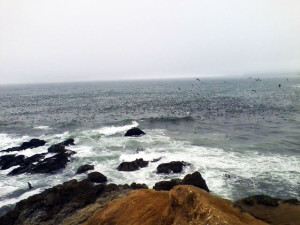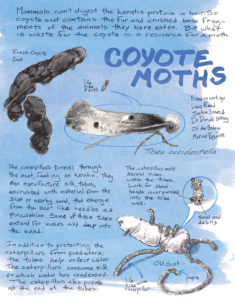Weighing in at almost 5,000 pounds, measuring over ten feet across, infested with scores of parasites, carrying more eggs than any other vertebrate, and shaped like a giant dinner plate—the giant ocean sunfish (Mola mola) is a creature defined by superlatives.
The most striking feature of this fish, aside from its leviathan proportions, is actually its lack of a feature: Mola mola never develop a true tail fin (known as a caudal fin). Early in its development, the fish’s caudal fin folds into itself to form a rounded rudder called a clavus, creating the mola’s distinct body shape. Mola mola have been described as resembling floating heads. In fact, the German name for the mola is Schwimmender kopf, or “swimming head.” The scientific name Mola mola comes from the Latin word for millstone, which likely refers to this fish’s gray coloring, rough sandpapery skin, and roundish shape. Their common name, ocean sunfish, comes from their affinity for basking in the sun at the water’s surface—where they are often spotted bobbing on their sides like giant, round life rafts.
Mola mola are big—really big. In fact, they are the heaviest of all the bony fishes (that excludes sharks and rays), with some recorded specimens tipping the scales at nearly 5,000 pounds. They have been known to reach 14 feet in vertical length and measure ten feet from head to clavus, where the tail should be. The average mola measures a respectable 5.9 feet in length and weighs around 2,200 pounds, which is still a whole lot of fish.
What the mola lacks in tail, it makes up for with its exaggerated, elongated dorsal and anal fins, which it uses to swim. They wag their dorsal and anal fins from side to side and steer with their rudder-shaped clavus. Though their swimming style is often described as clumsy, mola can be forceful swimmers, according to Tierney Thys, a Monterey-based marine biologist who closely studies these fish.
Thys and her colleagues have had great success attaching satellite tags to a number of Mola mola and other species of sunfish. The data they’ve collected so far tell of an “industrious” deepwater diver that makes repeated daily trips to cold ocean depths—not of a passive, lazy sunbathing drifter, which is what sunfish were once thought to be. Thys thinks this is consistent with their sunbathing habit—a tactic they use to store up heat energy or “thermally recharge” after deep dives.
Thys’s data also give more insight into the mola’s distribution. While the common mola and the other three species of sunfish are known to inhabit all tropical and temperate oceans, data collected from the satellite tags are allowing researchers to better understand the fish’s seasonal distributions. Here in Northern California, molas can regularly be spotted sunning themselves in the waters of the Gulf of the Farallones—and for those who don’t want to venture out on a boat to glimpse these amazing fish, the Monterey Bay aquarium has had great success in keeping Mola mola thriving in captivity. Over the course of 14 months, one mola housed in the aquarium’s Outer Bay exhibit gained over 800 pounds, feasting on a diet of squid, fish, and prawns. This particular specimen had to be airlifted out of the tank by helicopter and released back into the ocean after it grew too large for its tank!
But what does a fish this big eat in the wild? A whole lot. The Mola mola has a tiny mouth in comparison to its enormous body, with teeth that are fused into a beak-like structure. Molas don’t need to be fast to catch their preferred meal of jellyfish. They will also opportunistically feed on other pelagic, gelatinous invertebrates that may come close enough to be sucked into their small mouths. A mola renders its prey into bite-sized pieces by repeatedly sucking it in and spitting it out again. Then, teeth in the mola’s throat help grind food into smaller pieces. Unfortunately for mola, floating plastic bags closely resemble jellyfish—and these fish can choke on the bags or slowly starve as the plastic clogs their stomachs.
A remarkable party of parasites have been found to inhabit molas—some 40 different genera! The molas’ impressive parasite load might actually explain why these leviathans flood into Monterey Bay each fall. They find relief by soliciting the services of cleaner wrasses that live in the bay’s plentiful kelp beds. The wrasses are more than happy to remove a meal of parasites from the skin of visiting molas. Molas have also been observed breaching more than ten feet above the water—probably another tactic to dislodge itchy parasites from their bodies.
In the area of fecundity, molas again have bragging rights. One female mola can produce as many as 300 million eggs at a time—the most of any known vertebrate. Eggs are released into the water and externally fertilized by sperm.
A mola doesn’t start its life as a giant. A mola larvae is about one-tenth of an inch long and covered with needlelike spines. Only in this early stage does it show much resemblance to its relatives, the puffer and porcupine fishes. After that, it’s all about putting on weight. “If it lives to adulthood, a Mola mola can gain over 60 million times its starting weight. That’s the equivalent of a healthy, bouncing human baby growing to a weight equal to six Titanics,” Thys told National Geographic Online News.
Molas are harmless to people, but they can be very curious and regularly approach divers. While molas are eaten throughout Asia, they have little value as food in the United States and Europe. Sadly, they still face threats in California coastal waters: They are the most common bycatch of the drift net fishery. National Marine Fisheries reports from 1990 to 1998 show that Mola mola make up more than 25 percent of the California drift net bycatch.
Read about efforts to improve the health of Central California’s marine ecosystems in our October-December 2007 feature, Making Waves for a Healthy Ocean.
Sustainable seafood resources:
Monterey Bay Aquarium’s Seafood Watch
More about Mola mola, including photos:
University of New Hampshire’s Large Pelagics Lab Mola page
Marine photographer Michael Johnson’s photo gallery
National Geographic Species profile

.jpg)



